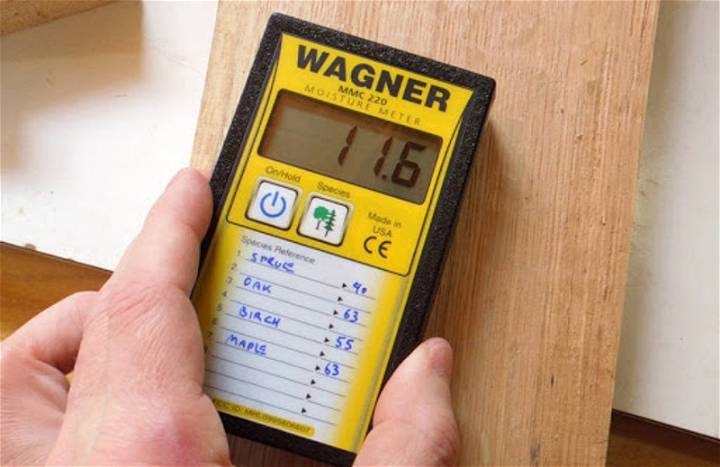When buying the wood for any DIY project, the moisture level content is an essential part to check. You cannot simply ignore this factor, as it will be an excellent deal for your wooden floor or furniture in the long run. Excess moisture content can cause the wood to deform, increase in size, or even grow a mold, which can ruin the wood from inside. Moisture Content is measured in percentages. By comparing the weight of dried-out wood and original wood's weight, you can easily calculate the moisture content percentage. The acceptable moisture content for wood used for flooring indoors and indoor furniture is 6-9%.

If you need your wood to last longer, make sure you measure the moisture content of the wood you are planning to purchase for your DIY project. Today, we are sharing some techniques to measure the wood moisture content for your DIY wood projects. It is so that the furniture lasts longer, and the flooring stays intact for a longer period and well. Don't you need a perfect way to measure the wood's moisture content you will use for your furniture? Cutting the wood by using a perfect track saw and then measuring wood's moisture content with an effective technique is recommended. There are many known ways to measure the wood's moisture content, but we share the readily available ones and easily understand it.
1) Oven or Kiln Dry Testing
The oven or kiln-dry testing is perhaps the oldest and by far the easiest method for measuring the wood's moisture content. Although it is a very time-consuming method, it provides the most accurate results if the whole procedure is followed correctly.
The process involves weighing the wood before, then placing it into the oven to dry. When the weight stops to drop any further, the wood is removed from the oven and weighed again. After the drying procedure, this new weight is compared with the wood's weight before placing it into the oven. The percentage thus calculated is actually the original moisture content of the wooden block.
Although this process is highly successful for measuring the moisture content, it comes with its own flaws. Some of the flaws are that after heating the wood for so long in the oven, you cannot use that wooden block again for building purposes. The process of drying the wood with the help of an oven sometimes over dries the wood to the extent that it cannot be used anymore. Another flaw of this method is that the drying process takes so long in the oven. This is a time-consuming method, and you will have to wait longer than you might expect for the wood to completely dry and stop dropping the weight any further.
Lastly, the procedure requires a special kind of kiln or oven capable of producing accurate results. Also, drying the wood in some oversized normal oven is not easy. You need a special kind of kiln for this process.
2) Moisture Testing and Control Meters
The fastest and most modern way to measure the wood's moisture content is with special meters, specially designed for this purpose. However, there are two types of moisture testing meters – pin-type wood moisture meters and pin-less wood moisture meters. Both kinds of meters have various features used to test the moisture level in the wood. We will be discussing both types separately to make the difference more clear.
a) Pin-Type Wood Moisture Meters:
The first types of moisture meters have electrodes like pins. The electrodes are used to penetrate the wood, for which you are going to measure the wood moisture content. The technique uses electrical resistance to measure the moisture content. Since wood is an insulator and water is a conductor, the amount of electrical resistance can determine the wood's dryness. The dryer the wood, the higher is its resistance. In other words, insert the electrode pins into the wood and activate the meter.
The meter will provide you with an accurate reading when the electric current is passed from one electrode pin. The less electric resistance in the wood indicates that the wood has higher moisture content and vice versa. The only flaw these meters have is that you have to leave tiny holes in the wood material for the electrode-pins to enter, so you can get a proper electrical resistance reading.
b) Pin-Less Wood Moisture Meters:
This second kind of moisture control meter has no pins, unlike the first one we discussed. This meter is also called 'damage-free' as you won’t have to pinholes in the wood for this one. It has a special scanning plate that helps pass the electromagnetic wave through the woodblock, thus creating a moisture content reading.
Pin-Less meters are more efficient as they scan a larger area, giving results for a larger woodblock. These meters do not leave holes in the woodblock for which the moisture content is to be measured. This is perfect for the wood flooring and different wood furniture, as there won’t be any damage to the hardwood.
Both kinds of moisture measurement meters have many modern features as well! Depending upon the company they are manufactured from. Some have built-in temperature corrections, and some even detect the wood specie you are measuring moisture content. These features can be checked while purchasing the meters; however, you might need expert assistance in learning the basics and moisture meters usage.
Conclusion
These are some of the most famous and easily used ways to measure the wood's moisture content that is used for indoor wooden furniture, floorings, and DIY projects. The expense rate of both types of moisture content reading techniques doesn’t vary much, as the meters can cost the same as that of the good over-sized kiln or oven used for technical purposes. However, measuring moisture content with a meter's help is an advanced and less time-consuming technique than the oven-dry method.

